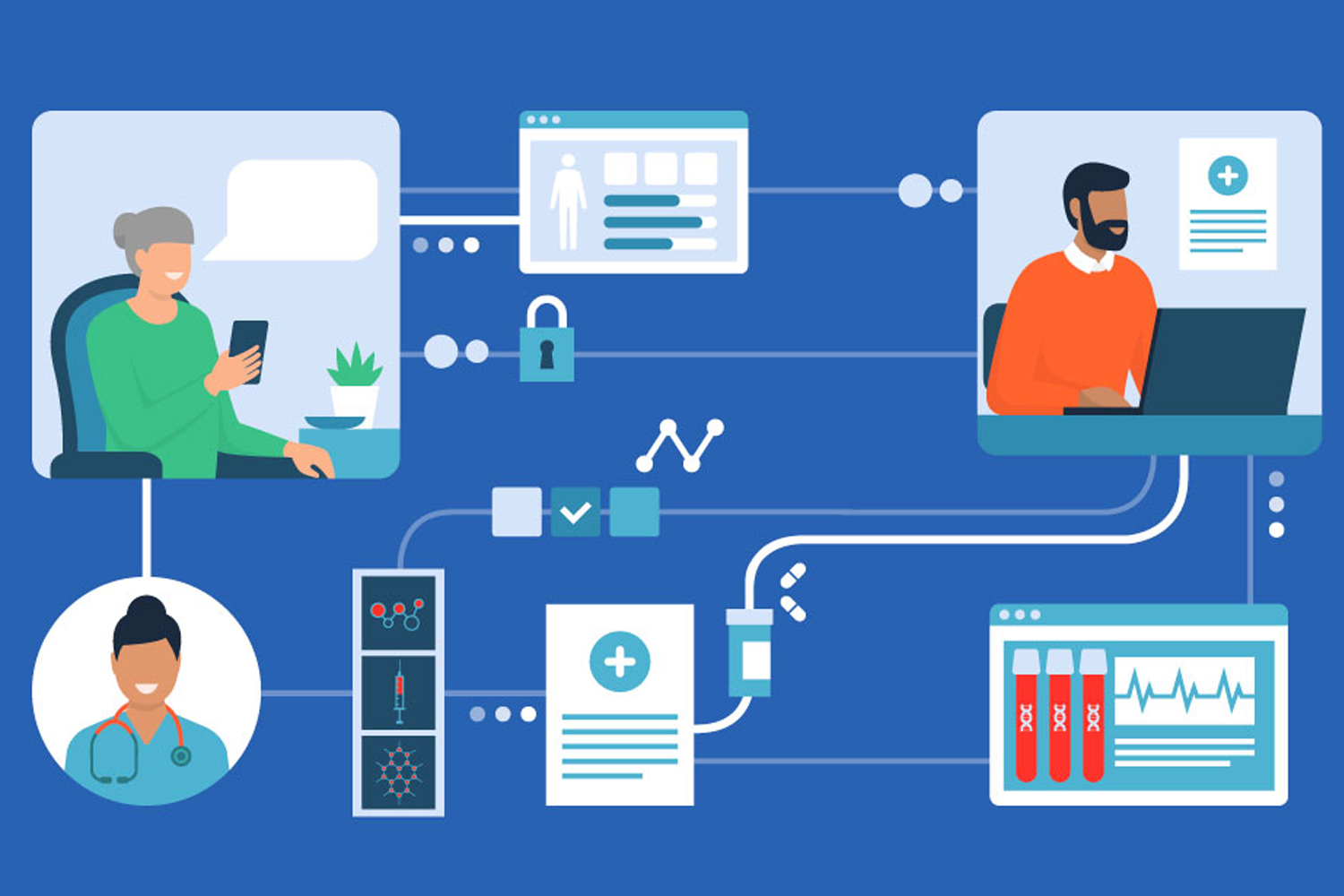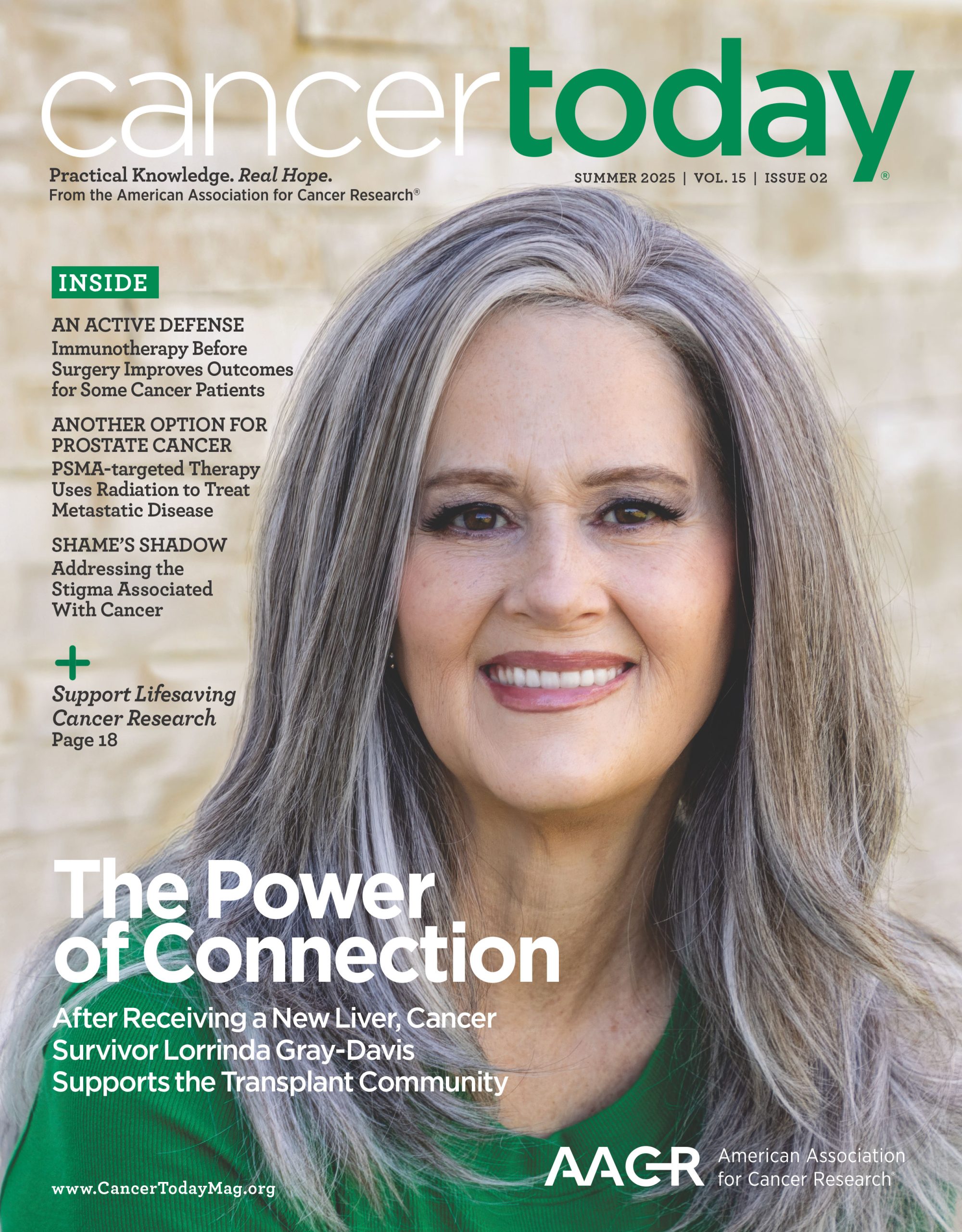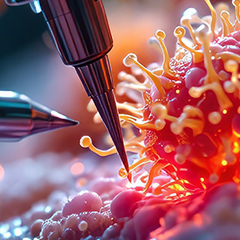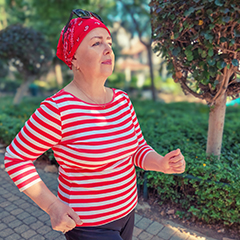FOR KYLE BREWINGTON, 32, cancer has been a reality since 2006, when he was diagnosed with osteosarcoma in his left tibia at the age of 13. The cancer recurred 10 years later. In 2022, Brewington, who lives in Fredericktown, Missouri, was diagnosed with a different cancer, renal cell carcinoma. While scrolling on a Facebook page for people with cancer, he saw a post asking fellow group members to consider contributing their clinical data and tumor samples for research.
The person who had written the post had recently contributed his data to Count Me In (CMI), a program launched by the Broad Institute of MIT and Harvard in Cambridge, Massachusetts. Brewington is fascinated by the science behind cancer and began reading about the work of CMI and the Broad Institute. He remembers looking at Broad’s extensive website and concluding that the program was well-funded. “As I dove in, I thought, ‘OK, this is legit,’” he says.
He learned that if he chose to join CMI, he would sign consent forms allowing the program to contact each of his doctors to request his medical records, as well as samples of any tumors removed in previous surgeries. He would complete surveys and submit saliva or blood for genome sequencing. The data would be anonymized and made available without charge to researchers studying cancer.
“At first it felt weird, signing over all of this medical stuff,” Brewington admits. But he believes strongly in the power of his data to help advance cancer research. “I was thinking that this could help other people,” he says, and he was interested in learning what he could about his own genome. “Between helping me and helping other people,” he says, “I figured it was important that I contribute.”
Fresh Approaches to Data Collection
Online platforms like CMI offer patients new ways to participate in research, even if they live far from cities or comprehensive cancer centers where many clinical trials are conducted.
“Every single one of us wants desperately to have some measure of control over the situation, even if just to help others,” says Corrie Painter, who was diagnosed with angiosarcoma in 2010 and helped launch CMI in 2015. “Why not convert all of [those medical records and tissue samples] into real data that can be used to understand and treat the disease?”
In 2010, Painter was 36 and the mother of two children under age 5. She was preparing to graduate with a PhD in biochemistry when she discovered a large lump in her right breast. She underwent a host of procedures before doctors confirmed that she had angiosarcoma, an aggressive cancer that forms in the endothelial cells that line blood and lymph vessels. Extremely rare, it is diagnosed in just 300 people in the United States each year. Painter had a mastectomy to remove the tumor.
As a scientist, Painter was devastated by the lack of data and research related to her cancer. “Even if you wanted to, how do you study something when there’s not enough patients to study?” she asks. Painter was also frustrated that her tumor slides remained in pathology storage, where they could not inform research. “My whole clinical history was just sitting there, and nobody was learning from it,” she says.
Painter’s oncologist at Dana-Farber Cancer Institute in Boston offered to treat her with chemotherapy drugs, suggesting they might control the cancer. Painter chose to complete three rounds of gemcitabine with paclitaxel in 2010. Given that she had no evidence of disease after treatment, she decided to stop at that point. She has taken a watch-and-wait approach ever since and was healthy enough to pursue a postdoctoral fellowship in cancer immunology.
In 2015, Painter applied for a role at the Broad Institute that appeared to fit her perfectly. “They wanted a scientist who understood cancer research and who wanted to make sweeping changes in the way that data was collected and that patients were involved in cancer research,” she says. Painter was soon hired as the associate director of scientific outreach and operations for the program that would eventually become CMI. In 2022, Painter left CMI to become vice president of external research and partnerships at Precede Biosciences in Boston.
Scientists at the Broad Institute had previously pioneered rapid whole genome sequencing, which allows scientists to examine a person’s genes for mutations, and whole exome sequencing, which focuses solely on the protein-coding region of genes. Researchers estimate that 85% of all disease-causing gene mutations—including those linked to tumor progression—are found in the exome. This information can be captured by analyzing a patient’s saliva, blood or tumor tissue.
CMI began its efforts to collect patient data with metastatic breast cancer. Painter spent many hours contacting people with the disease through social media, talking with them to understand how she could earn their trust so they would feel comfortable sharing medical data with researchers. Patients advised the Broad Institute team as they designed the data-collection website and fine-tuned survey questions. Painter and her colleagues began inviting people to sign up to share their data in 2015, and patients helped spread the word to one another.
Today, CMI has collected data from more than 12,000 patients with an array of cancer types, including rare cancers. Once a patient agrees to join and signs the consent and medical release forms, a team begins to contact clinics to request the patient’s medical records and archived tumor samples. The patient records are turned into digital data researchers can use. Tumor tissue is sequenced. Patients are also invited to complete surveys that describe their cancer journey. All of these data are “de-identified” yet provide a rich dataset for scientists who might want to know a number of things about a patient’s cancer, including which previous treatments the patient has undergone.
CMI’s work has yielded valuable answers. It followed the launch of the Metastatic Breast Cancer Project with the Angiosarcoma Project. Data from more than 300 angiosarcoma patients were collected, and when data from 70 of them were analyzed, Painter noted a high tumor mutational burden among some of the patients, suggesting they would likely respond positively to checkpoint inhibitors such as Keytruda (pembrolizumab). This observation led to clinical trials. “We ended up making clinical discoveries within two years of launching that changed clinical practice in that cancer,” Painter says. “Now doctors treat that cancer differently,” and patients with a high tumor mutational burden are offered checkpoint inhibitors.
Another CMI project that focused on metastatic prostate cancer studied data from more than 700 patients across the U.S. and Canada. A 2022 study from this project confirmed previous findings about the genetic mutations common in this disease. The researchers also noted that 41% of the patients were from rural or medically underserved areas, regions that are often overlooked in cancer research.
Fixed Versus Live Tissue
CMI collects fixed tumor specimens. When a tumor is removed from a patient’s body during surgery, it is typically preserved, or fixed, in wax and formalin, which prevents the tissue from changing over time. These tissue blocks can be stored at room temperature and used to sequence the tumor’s DNA. Because these blocks may also be used by the patient’s oncologist to determine treatment, CMI has created internal rules limiting the size of tumor specimens it requests. “We make sure that we’re never taking away tissue that could be used in the future for the patient’s clinical care,” explains Elana Anastasio, CMI’s director of project strategy and development.
The vital work of creating new cell lines and mouse models to study a cancer’s cell biology and possible treatments requires live tumor samples, which must be used within hours of removal from a patient’s body. Seven years ago, the Rare Cancer Research Foundation (RCRF) addressed these challenges by launching Pattern.org, a live tissue donation program.
“Patients can sign up online and consent to our research protocol to donate their fresh living tissue directly to researchers who are trying to do this kind of work,” says Marshall Thompson, RCRF president. Once a patient shares the date and location of their surgery, the Pattern.org team mobilizes to contact the surgeon or pathologist, send a collection kit and answer questions during surgery if needed. “If there’s excess tissue, that goes into our collection kit and gets shipped overnight directly to researchers who are doing model development or cutting-edge diagnostics that can only be done on living tissue,” he says.
The challenge is spreading the word about Pattern.org so patients and doctors know about it before surgery, Thompson says. Pattern.org has collected data and tissue for about 400 patients to date, which has led to the development of more than 65 new cancer cell lines, most in the realm of rare cancers. For example, one patient sample led to the development in 2023 of the first publicly available desmoid tumor cell line.
Pattern.org is also developing a biobank that will freeze live tumor samples with liquid nitrogen, allowing them to be stored after surgery but remain viable.
Solutions for Scarce Information
Aggregating data of all types is particularly helpful for rare cancers. Consider Katie Coleman’s story. She was a 29-year-old newlywed when she noticed a hard mass on the right side of her abdomen in 2020. She had been experiencing other symptoms for months, including high blood pressure, rapid heart rate and painful abdominal cramps, which multiple doctors attributed to her menstrual cycle and anxiety.
Once she felt the mass in her belly, Coleman went to a hospital emergency department, where an ultrasound revealed a softball-sized tumor on her right kidney and a number of small tumors in her liver. Her radiology report indicated that she likely had one of two types of metastatic kidney cancer: chromophobe renal cell carcinoma or an oncocytoma, both very rare.
In the whirlwind of initial oncology appointments, biopsies and second opinions, Coleman tried to learn all she could about these cancers but discovered that information was alarmingly scarce. She was ultimately diagnosed with an oncocytoma, a tumor type that is typically noncancerous. But in a few cases, like Coleman’s, the tumor is malignant and metastasizes to the liver or bones.
This scenario is so uncommon—with fewer than 10 cases ever recorded—that most oncologists will never see a patient with this cancer. Coleman was initially told she was not a candidate for surgery and her prognosis was dire.
By connecting online with other patients with rare kidney cancer, Coleman, who lives in Austin, Texas, ultimately met physicians at the National Cancer Institute in Bethesda, Maryland, one of whom had experience treating oncocytoma. At their recommendation, she had surgery to remove her primary tumor, her right kidney and five sections of her liver. She also underwent ablation to treat the remaining tumors in her liver. These interventions left Coleman, now 33, with no active cancer and a deep appreciation for the ways that patients with rare cancers can band together to help each other.
Coleman began advocating for patients with rare kidney cancers, especially chromophobe kidney cancer, which is rare but more common than her own cancer. In 2023, she established the Chromophobe and Oncocytic Tumor Alliance, hoping to make an impact for those patients.
Coleman decided to use her skills as a software engineer to address the lack of centralized information about rare kidney cancers. She was inspired by a paper co-authored by her oncologist, Pavlos Msaouel of the University of Texas MD Anderson Cancer Center in Houston. The paper described the molecular characteristics of different kidney cancers, focusing on the limited response rate of chromophobe kidney cancer to immunotherapy. At the time, many patients were asking Coleman about immunotherapy, which is often prescribed to treat the more common subtypes of kidney cancer. “I needed community oncologists to see this paper. They weren’t seeing this information and were prescribing differently.”
Over a long holiday weekend in 2023, Coleman built an app that consolidated large amounts of information about these kidney cancers. “My goal was that if there was a brand-new researcher entering the space and they had to choose between breast cancer, which has all this accessible information, or a rare cancer where the information is really hard to find,” she says, “I wanted to give them a leg up and a better starting place.”
Regulations on the ownership of medical data and tissue samples affects how they can be shared and used.
Patient data and tissue samples are valuable resources that can fuel discoveries about cancer. But the rules about who owns these resources are somewhat complex, established through court cases decided many decades ago. Marshall Thompson, president of the Rare Cancer Research Foundation, offers his insights into who owns these materials.
Electronic Medical Records. “Most laws are very clear: the patient owns this data,” Thompson says. “Everybody has sort of agreed that your medical records belong to you.”
Tumor Tissue. “As soon as tissue is removed from the patient, it belongs to the hospital or the sponsor of the research study under which it was taken,” he says. This means that if a patient donates part of their tumor to Pattern.org, for example, “the legal ownership of it transfers to Pattern,” Thompson says. He adds that if a patient’s tumor tissue is used to test pharmaceuticals, some pharmaceutical companies require that ownership of the tissue transfers to them.
Test Results. The Health Insurance Portability and Accountability Act (HIPAA) establishes national standards to protect patients’ health information. HIPAA states that “if a test is done on you, you are authorized to receive those results,” Thompson says. But for the results to come back to the patient, a test or procedure must be approved through the Clinical Laboratory Improvement Amendments (CLIA), created to protect patients from unapproved testing. This means that patients are sometimes not allowed to receive findings related to clinical trials or new testing protocols. In many cases this is problematic. Thompson would like researchers to establish guidelines at the start of a study for getting information back to patients.
“I personally feel researchers have a responsibility to provide as much useful and actionable data back to patients as possible,” he says. “I do think it is important that patients be aware of the implicit conflicts in the regulations.” Better regulations “will only happen if enough people call out the issue.”
Coleman’s app went live just before the 2023 American Society of Clinical Oncology Annual Meeting, where she happened to meet Barbara Van Hare, president of Pattern.org. Coleman was quickly hired by RCRF, which will soon launch an enhanced version of her app called the Rare Cancer Research Hub. Pattern.org also offers an online portal, created by Coleman, that allows patients to share their data and medical history with clinicians and researchers.
Questions Around Data Sharing
Coleman has been eager to share her data on platforms like Pattern.org. “I don’t mind sharing because what I care more about than anything is moving research forward,” she says.
Yet others may feel anxious about sharing their data and have reasons for not participating. In his conversations with other patients, Kyle Brewington encourages people to take part, if only to get access to the data about their genes. But he finds that sometimes patients or patients’ parents, in the case of childhood cancers, are not in a place to participate in research. “They’re mid-treatment, and they’re more worried about their child surviving,” he says.
CMI and RCRF take privacy seriously, ensuring that data and tissue are anonymized before they are shared with researchers. But Painter says this kind of data sharing is not for everyone. “If people have real concerns, please don’t join,” she says. She believes it’s important to be transparent about potential risks of sharing data. “The risk is very, very low,” she says, but there are still risks associated with sharing data on any platform. Elana Anastasio of CMI adds, “We’re always happy to have a conversation with patients if they don’t feel comfortable with any part of the process, the data or otherwise.” She says that CMI has also connected with patients who don’t feel comfortable sharing their data but still advocate for CMI, spreading the word about it to their friends and social media contacts.
Whatever way patients choose to participate, the success of these efforts illustrates the power of a single person with cancer to advance knowledge of their disease, says Susan Horrell, director of strategic partnerships at RCRF. “There is an opportunity for everyone at every hospital, wherever you are in the world, to help research,” she says.
Cancer Today magazine is free to cancer patients, survivors and caregivers who live in the U.S. Subscribe here to receive four issues per year.





